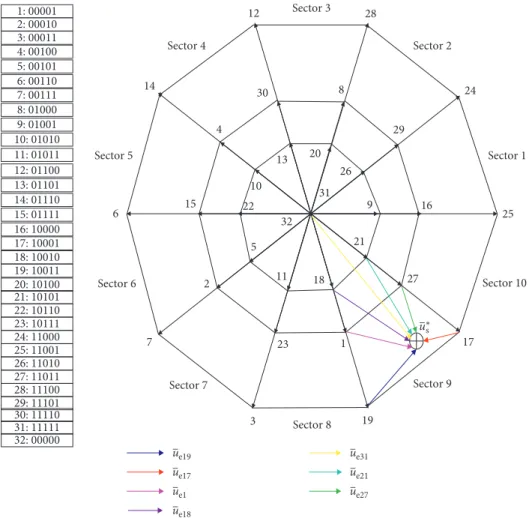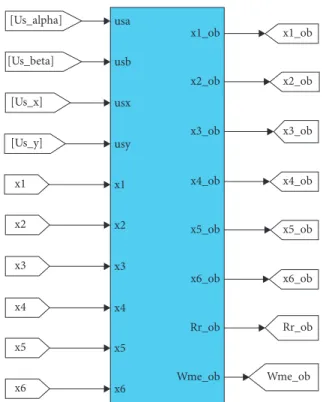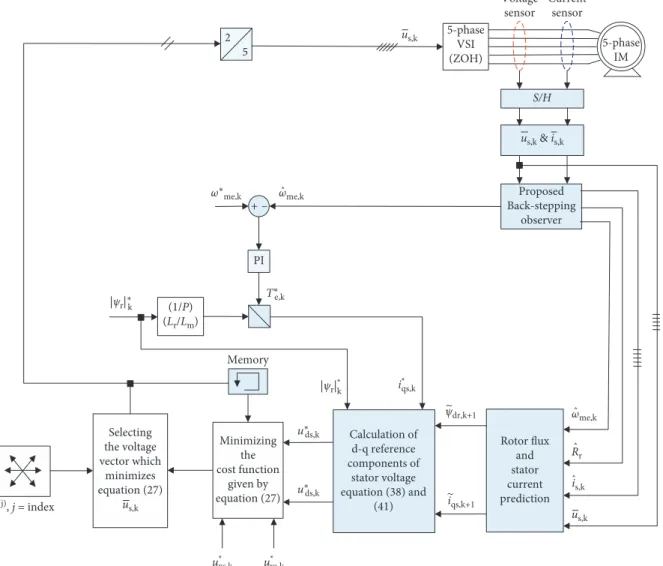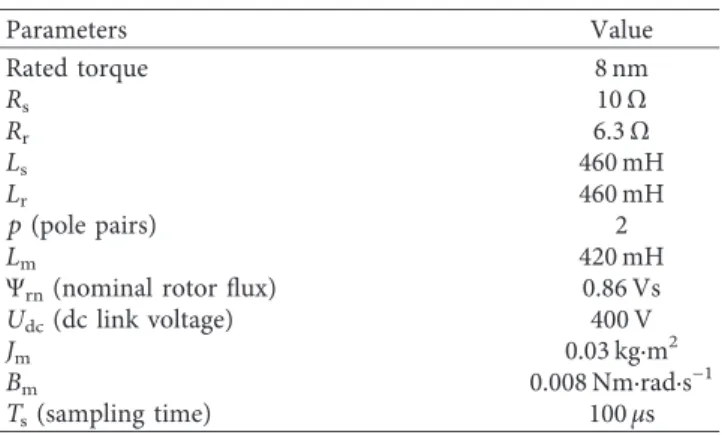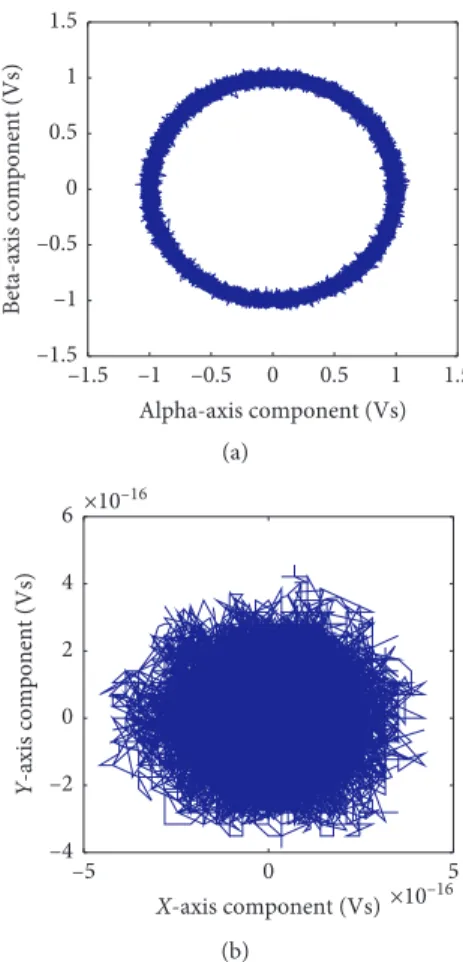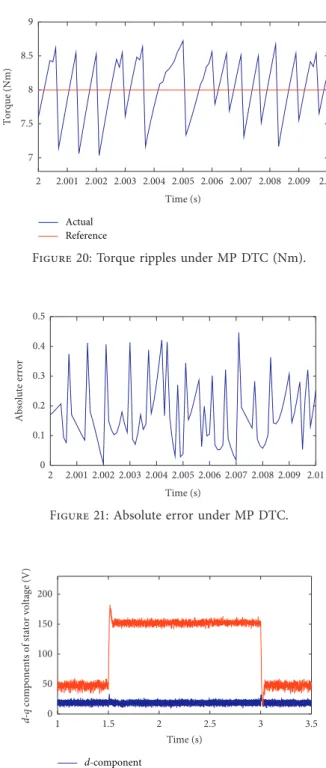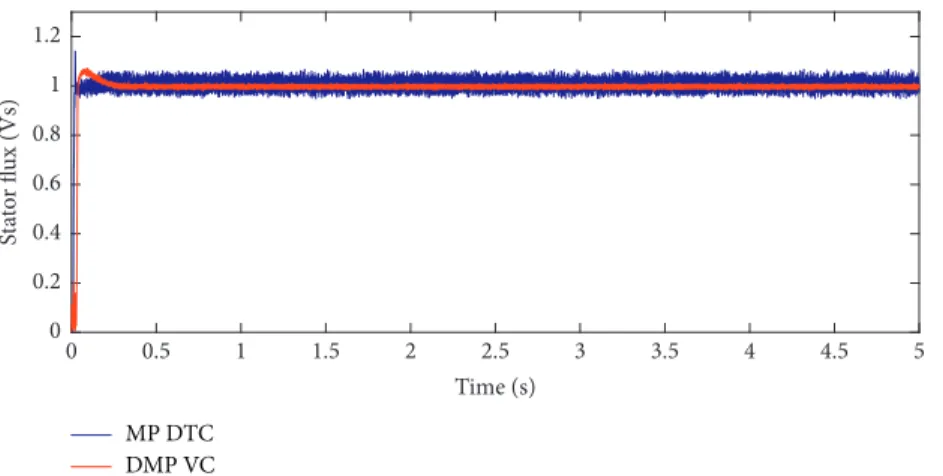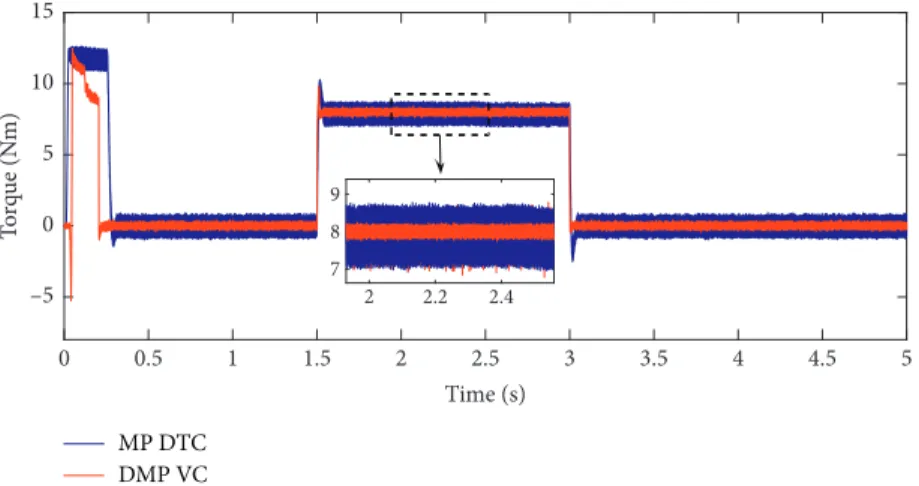Research Article
Deadbeat-Based Model Predictive Voltage Control for a Sensorless Five-Phase Induction Motor Drive
Mahmoud A. Mossa ,
1Nguyen Vu Quynh ,
2Hamdi Echeikh ,
3and Ton Duc Do
41Electrical Engineering Department, Faculty of Engineering, Minia University, Minia 61111, Egypt
2Electrical and Electronics Department, Lac Hong University, Dong Nai, Vietnam
3Department of Electrical Engineering, National Engineering School of Monastir, P.O. Box 5035, Monastir, Tunisia
4Department of Robotics and Mechatronics, School of Engineering and Digital Sciences (SEDS), Nazarbayev University, Nur-Sultan Z05H0P9, Kazakhstan
Correspondence should be addressed to Mahmoud A. Mossa; [email protected] and Nguyen Vu Quynh;
Received 16 April 2020; Accepted 11 June 2020; Published 15 July 2020
Academic Editor: Salvatore Strano
Copyright © 2020 Mahmoud A. Mossa et al. This is an open access article distributed under the Creative Commons Attribution License, which permits unrestricted use, distribution, and reproduction in any medium, provided the original work is properly cited.
This paper introduces a direct model predictive voltage control (DMP VC) for a sensorless five-phase induction motor drive. The operation of the proposed sensorless DMP VC is based on the direct control of the applied stator voltages instead of controlling the torque and flux as in model predictive direct torque control (MP DTC). Thus, the simplicity of the control system is enhanced, which saves the computational time and reduces the commutation losses as well. The methodology based on which the proposed sensorless DMP VC performs its operation depends on minimizing a cost function that calculates the error between the reference and actual values of the direct and quadrature (d-q) axes components of stator voltages. The reference values ofd-qcomponents of stator voltages are obtained through incorporating the deadbeat control within the proposed model predictive system. A robust back-stepping observer is proposed for estimating the speed, stator currents, rotor flux, and rotor resistance. The validity of the proposed sensorless DMP VC is confirmed through performing detailed and extensive comparisons between the proposed DMP VC and MP DTC approach. The obtained results state that the drive is exhibiting better performance under the proposed DMP VC with less ripples content and reduced computational burden. Moreover, the proposed back-stepping observer has confirmed its effectiveness in estimating the speed and other variables for a wide range of speed operation.
1. Introduction
Recently, the multiphase machine drives have been given great concern due to their various advantages compared with the three-phase AC machine drives [1–3]. These ad- vantages can be addressed in the form of high robustness, smooth torque profile, reduced ripples content in the controlled variables, reduced current rating for each phase of the stator, and enhanced fault-ride through capability [4–6].
All of these merits have motivated the industrial commu- nities to use the multiphase machines in high-power ap- plications such as aircraft and naval propulsion and electric traction systems, as well as aerospace applications [7–9].
One of the most familiar types of multiphase machines is the five-phase induction motor (FPIM) [10–12]. Many control topologies have been presented for controlling the operation of the FPIM drives so that an optimal performance can be obtained from the drive in terms of low ripple contents, high efficiency, and ease of practical imple- mentation. The direct torque control (DTC) and field ori- ented control (FOC) are considered as the most used control topologies for the majority of electric machine drives [13–16]. Both techniques have contributed effectively to improving the dynamic performance of the FPIM drive, but on the other hand they have suffered from some problems.
For example, for the FOC approach, the system complexity
Volume 2020, Article ID 4164526, 30 pages https://doi.org/10.1155/2020/4164526
is obvious due to the utilization of multiple proportional- integral (PI) controllers, which require precise tuning of its coefficients. This is in addition to the time delay, which is added to the system response due to the use of PI controllers [13, 14]. On the other hand, the DTC control approach has managed to reduce the system complexity and achieve fast dynamic response as well. However, it has suffered from the remarkable ripples content in the controlled variables [15, 16].
To overcome the shortages of the DTC and FOC ap- proaches, the model predictive control (MPC) principle has been presented for the FPIM drive in different forms. Some of these forms have depended on controlling the torque and flux and were entitled as model predictive direct torque control (MP DTC) [12, 17]. The MP DTC approach has succeeded in reducing the system complexity and reducing the ripples compared with the classic DTC look-up table based approach, but the ripples have not been totally suppressed.
However, the MP DTC has suffered from the high computational burden, which cannot be realized by all microprocessors. The main factor that manages the com- putation time in the model predictive control in general is the form and parts of the used cost function. For example, for the MP DTC, the cost function is consisting of two parts:
one for the torque regulation and the other for the flux management. This function type requires the utilization of a weighting factor to weigh the importance of each term with respect to the other. The calculation of optimal weighting factor is a time-consuming process, which results in adding extra execution time and increasing the commutation losses.
This is in addition to the fact that both terms (torque and flux) need to be estimated, which again lengthens the computational time for each cycle.
As a solution for these issues, the current paper proposes a direct model predictive voltage control (DMP VC) ap- proach for a sensorless FPIM drive. The operation of the proposed approach is based upon utilizing a cost function form, which consists of two similar terms to avoid using a weighting factor. The two similar terms of the cost function are the errors between the reference values of direct- quadrature (d-q) axes components of stator voltage and their correspondent actual values. Through checking the cost function configuration as will be illustrated later, it can be realized that the cost function’s variables (the voltages ap- plied to the motor terminals) can be directly accessed without performing any estimation. This procedure has resulted in reducing the calculation time of the cost function, which reduces the commutation time as well as switching power losses. Moreover, the control is now dealing directly with the fastest variable to be applied to the PFIM (which is here the stator voltage), and this results in enhancing the system dynamic response.
To increase the robustness of the FPIM drive, several sensorless schemes have been proposed for estimating the rotor speed and rotor flux. Some of them have depended on utilizing the model reference adaptive system (MRAS) ob- server [18–20]. The main deficiency of the MRAS observer is the sensitivity to parameters variation, especially at low
speed operation. Other sensorless schemes have utilized the sliding mode observer [21, 22]. The precision of the speed estimation using the sliding mode observers has been negatively affected by the noise characteristics. Moreover, in order to solve the chattering problem, higher-order sliding modes have been utilized, which resulted in increasing the system’s complexity. Another senseless procedure has implemented the extended Kalman filter for estimating the speed [23]. The main issue related to this scheme is the dependency of the observer’s model on the parameters, which can result in deteriorating the estimation due to the parameters variation under certain operating conditions.
Another scheme has depended on estimating the rotor position through tracking the saliency position [24]. This method has suffered from the increased computational capacity of the system due to the system complexity.
As an attempt to achieve robust and precise speed es- timation without adding extra computational burden on the controller, a new back-stepping speed observer is presented in this paper. The proposed back-stepping observer not only estimates the speed but also estimates the stator current, the rotor flux, and rotor resistance. Checking the observer’s stability has been presented to confirm its effectiveness in estimating the speed precisely for a wide range of operations under varying the rotor resistance. It is worth mentioning that the back-stepping principle has been introduced for different AC machine drives as a control system [25, 26], but it has been rarely utilized as a speed observer.
The back-stepping approach is a recursive procedure, the operation of which is based on the Lyapunov theory. This strategy is widely used for designing the control laws for uncertain systems. To our knowledge, majority of the methods that have been used for observing the states of the induction machine depending on the back-stepping prin- ciple and introduced in the literature have been mainly utilized for estimating the resistive and inductive parameters of the machine in the presence of mechanical speed sensor.
However, the difficulties are coming out when eliminating the speed sensor because of the unobservability of the motor, especially at very low speed. It is shown that the proposed method in [27] must be modified to take into account this nonlinear dynamic coupling by introducing other damping terms into each control input. The second contribution that the paper presents is to apply the back-stepping observer to the systems that have high degree of coupling between the electromagnetic and mechanical variables. In this form, the nonlinearities entering each subsystem are allowed to de- pend on the output associated with the subsystem and the states of the upper subsystem, including the unmeasured ones. The proposed observer algorithm is applied to the five- phase induction motor. The proposed observer only takes the stator voltages and currents as inputs and provides the speed, the rotor flux, the stator current, and rotor resistances as estimated outputs.
The paper is organized as follows; it starts with intro- ducing the mathematical model of the five-phase IM (FPIM) drive. Then, in Section 3, the proposed DMP VC approach is described and analyzed in detail. After that, in Section 4, the proposed back-stepping observer is presented and
explained. In Section 5, the complete system configuration is presented. In Section 6, the test results are introduced and discussed. The test results are presented in the form of comprehensive comparisons between the proposed DMP VC and MP DTC approach. Finally, Section 7 introduces the conclusion and the outcomes of the paper.
The contributions of the paper can be addressed through the following items:
(i) The proposed DMP VC approach has not been tested before with the FPIM drive.
(ii) The derivation and analysis of the proposed DMP VC are performed through a detailed mathematical verification so that the base principle can be easily understood.
(iii) The proposed back-stepping observer has been presented and analyzed in detail so that the oper- ation principles of the observer can be easily verified.
(iv) The robustness of the proposed back-stepping ob- server has been verified under the parameters variation for a wide range of speed operation.
(v) A detailed comparison between the proposed DMP VC and MP DTC for the FPIM drive is carried out in terms of the total harmonic distortion (THD) for the current signals and in terms of the average error values. Moreover, a comparison has been carried out in terms of switching frequencies and number of commutations and finally in terms of the compu- tational time and switching losses.
2. Mathematical Model of FPIM
Several studies have presented and formulated the mathe- matical model of FPIM according to specific assumptions [28, 29]. The model can be represented in different reference frames, such as the rotating synchronous reference frame, which gives the (d-q-x-y) axes configuration, while repre- senting the model in the stationary reference frame gives the (α-β-z1-z2) axes configuration.
When representing the FPIM model in the synchro- nous reference frame, the d-q components will be re- sponsible for managing the flux and torque, respectively.
Meanwhile, the x-y components will be responsible for developing the losses.
Under rotor field oriented control (RFOC), the following discretized relationships are obtained at instant kTs as follows:
ψrfdr,k�ψrfr,k, ψrfqr,k �0.0,
(1)
where Ts is the sampling time;ψrfdr,k and ψrfqr,k refer to the direct and quadrature axes components of stator flux defined in the synchronous rotating frame. Moreover, the super- script “rf” is used to state that the variables are defined in a reference frame, which rotates synchronously with the rotor flux.
Utilizing (1) and via adopting the principles of RFOC, the equations that describe the electric dynamics of the FPIM can be represented in the (d-q-x-y) reference frame by
dψrfdr,k dt �dψrfr,k
dt �Lm τr
irfds,k− ψrfdr,k τr
, (2)
dψrfqr,k
dt �0.0�Lm
τrirfqs,k− ωsl,kψrfdr,k, (3) dirfds,k
dt �c1irfds,k+ωme,kirfqs,k+c2ψrfdr,k+ 1
Lturfds,k, (4) dirfqs,k
dt �c1irfqs,k− ωme,kirfds,k+c2ψrfdr,k+ 1
Lturfqs,k, (5) dirfxs,k
dt �−Rs Llsirfxs,k+ 1
Llsurfxs,k, (6) dirfys,k
dt �−Rs Llsirfys,k+ 1
Llsurfys,k, (7) dωme,k
dt �c3ψrfdr,kirfqs,k− p
JTl,k, (8)
where the subscripts s andr refer to the stator and rotor variables, respectively, and
c1�L2mRr+L2rRs LtL2r , c2�LmRr
LtLr, c3�p2Lm
JLr , ωsl�ωψr− ωme,
(9)
whereωψris the angular frequency of the rotor flux,ωmeis the mechanical angular frequency, andωslis the slip angular frequency. The parametersRsandRrrefer to the stator and rotor resistances, respectively. The inductances Ls, Lr, Lm, and Lls refer to the stator, rotor, magnetizing, and stator leakage inductances, respectively. The inductance Lt�σLs refers to the stator transient inductance, while the constant σ �1− (L2m/LsLr) refers to the total leakage factor. The parameterspandJrefer to the pole pairs and the moment of inertia, respectively. Finally, τr�Lr/Rr refers to the rotor time constant.
Via utilizing the relationships (2) to (8), the equivalent circuit of the FPIM can be represented as shown in Figure 1.
In this figure, it can be noticed that the model is consisting of decoupled d-q axes equivalent circuits similar to those of three-phase IM, decoupledx-yaxes equivalent circuits, and decoupled x-y axes equivalent circuits for the rotor. The latter can be simply represented by resistive-inductive circuits.
3. The Proposed DMP VC Approach
The principle based upon which the proposed DMP VC approach is formulated states that the motor’s flux and torque can be directly controlled via controlling the direct and quadrature (d-q) axes components of applied stator voltage (urfds,k, urfqs,k), respectively. This argument can be verified mathematically as follows.
Under RFOC, the total rotor flux is aligned with thed- axis of the rotating reference frame, and the following re- lationships are obtained:
ψrfr,k�Lrirfr,k+Lmirfs,k�Lmirfmr,k, (10) whereirfmr,kis the rotor magnetizing current andirfs,kandirfr,k are the stator and rotor current vectors, respectively.
The relationship between the stator, rotor, and mag- netizing currents can be represented by
irfmr,k �ψrfr,k Lm � Lr
Lmirfr,k+irfs,k. (11) Under the RFOC, the reference frame rotates with an angular speed defined by
ωψr,k�ωme,k+ irfqs,k
√√ωsl,k
τrirfmr,k
. (12)
The space vector representation under the application of RFOC is illustrated in Figure 2, through which it is observed that the total rotor flux is fixed with thed-axis of the rotating frame and rotates with an angular frequency of ωψr,k. The angleδkrefers to the load angle (torque angle) between the rotor flux and stator current vectors. The stator current vector rotates with an angular frequency of ωs,k�d/dt(δk+θψr,k).
The voltage balance in the FPIM circuit can be expressed in an alternative form by the following relationships:
urfs,k �Rsirfs,k+dψrfs,k
dt +jωψr,kψrfs,k, (13)
urfr,k�0�Rrirfr,k+dψrfr,k
dt +jωψr,k− ωme,k
√√√√√√√√√√ωsl,k
ψrfr,k. (14) By substituting (11) and (12) into (13) and (14), and after mathematical derivations, this results in
urfds,k�Rsirfds,k+(1− σ)Lsdirfmr,k
dt +σLs dirfds,k
dt − irfqs,kωψr,k
,
(15)
urfqs,k �Rsirfqs,k+(1− σ)Lsirfmr,kωψr,k+σLs dirfqs,k
dt +irfds,kωψr,k
⎛⎝ ⎞⎠,
(16)
+ –
– +
Rr Llr Rs Lls – +
ψqsrf
ωψr ωslψrfqr
ids idrrf
urfdr
urfds Lm
rf
(a)
Rr Llr Rs Lls
ψrfds
ωψr ωslψdrrf iqrrf
urfqr
urfqr
iqsrf
– +
Lm
+ - – +
(b) Rs Lls
Rs Lls
urfxs uysrf
– –
+ +
ixsrf iysrf
(c)
Rr Llr Rr Llr
ixrrf iyrrf
(d)
Figure1: (d-q-x-y) axes equivalent circuit model of FPIM defined in synchronous reference frame. (a)d-axis equivalent circuit, (b)q-axis equivalent circuit, (c)x-yaxes equivalent circuits for stator side, and (d)x-yaxes equivalent circuits for rotor side.
Stator axis Rotor flux axis
iαs iqs
θψ–r
ωψ–r ωs
δ i–
s
iβs
ids = (ψr/Lm) = imr
Figure2: Vector diagram for steady-state operation of IM under RFOC.
τrdirfmr,k
dt +irfmr,k �irfds,k, (17) J
p dωme,k
dt �1√√√√√√√√√√√√.5p(1− σ)Ls
∇
irfmr,kirfqs,k
√√√√√√√√√√√√√√√√√√Te,k
− Tl,k. (18) Using (17) and its derivative, by substituting into (15), this results in
urfds,k�σLsτrd2irfmr,k
dt2 + Rsτr+Lsdirfmr,k dt +Rsirfmr,k− σLsirfqs,kωψr,k.
(19)
By taking the Laplace transform of (19), this results in urfds,k(s) �σLsτrs2irfmr,k(s)+ Rsτr+Lssirfmr,k(s)
+Rsirfmr,k(s) − σLsLirfqs,kωψr,k,
(20)
where L denotes Laplace transform. Then the value of irfmr,k(s)can be derived from (20) by
irfmr,k(s) � 1/Rsurfds,k(s) +στsLirfqs,kωψr,k
στsτrs2+ τs+τrs+1 , (21) where τs is the stator time constant that is equal to τs�Ls/Rs.
The characteristic polynomial equation of the transfer function given by (21) has always real eigenvalues, which can be derived as follows:
στsτrs2+ τs+τrs+1�0.0,
s1,2�− τs+τr 2στsτr ±
���������������
τs+τr2− 4στsτr
2στsτr . (22) To get real eigenvalues, the quantity under root square
���������������
(τs+τr)2− 4στsτr
must be larger than 0.0; thus, z�τ2s+τ2r+2τsτr− 4στsτr>0.0, (23) and thus (21) can be rewritten by
irfmr,k(s) � 1/Rsurfds,k(s) +στsLirfqs,kωψr,k 2στsτr/ τs+τr− �
√z
s+1+ 2στsτr/τs+τr+ �
√z
s+1. (24)
From (24), it can be realized that the termL(iqsωψr)can be recognized as a disturbance on which the control system has to be robust.
Now, from (10), (11), and (24), the transfer function that relates to the rotor flux and the input d-axis stator voltage component can be expressed by
ψrfr,k(s) � Lm/Rsurfds,k(s) 2στsτr/ τs+τr− �
√z
s+1+ 2στsτr/τs+τr+ �
√z
s+1
+ σLmτsLirfqs,kωψr,k 2στsτr/ τs+τr− �
√z
s+1+ 2στsτr/ τs+τr+ �
√z
s+1.
(25)
Assuming that, under steady-state operation, the current irfmr,k is constant, from (16), the Laplace transform ofirfqs,k(s) can be obtained and expressed by
irfqs,k(s) �
1/Rs urfqs,k
√√
−LsLirfqs,kωψr,k
στss+1 . (26) From (25) and (26), the argument that states that the flux and torque of the FPIM can be regulated using the d-q components of stator voltage is verified and approved. Then, via substitution from (12) and (18) into (26), the mathe- matical model of FPIM can be obtained in the functional diagrams as shown in Figures 3 and 4.
After approving the hypothesis of controlling the torque and flux directly through controlling thed-qcomponents of the applied stator voltage, the cost function to be utilized by the proposed DMP VC can be formulated by
Cjk�uds,k∗ − urfds,kj+uqs,k∗ − urfqs,kj+0.0− urfxs,kj+0.0− urfys,kj, (27) where jdenotes the voltage index.
By checking the terms of the cost function (27), it can be realized that the terms are of the same type and thus there is no need to utilize a weighting factor, which saves the com- putation time. Moreover, it can be noticed that the controlled variables (the stator voltage componentsurfds,k,urfqs,k,urfxs,k, and urfys,k) can be directly obtained via three different procedures;
the first choice is obtained via direct measurements using filters, but this solution is not preferred due to the delay in the system response. The second way to get the voltage com- ponents is through calculating the voltages with the help of pulse width modulation (PWM) using the switching states, but this method results in varying and high-switching fre- quencies, which increases the switching losses. The third
method is to adopt the finite control set (FCS) principle and calculate the voltages from the switching states (Sa,Sb,Sc,Sd, andSe) of the inverter, and this method is adopted here due to
its simplicity and reduced computational burden. The cal- culation of the voltages using the switching states is illustrated by the following formulations:
uas,k�Udc
5 4Sa− Sb− Sc− Sd− Se, ubs,k�Udc
5 4Sb− Sa− Sc− Sd− Se, ucs,k�Udc
5 4Sc− Sa− Sb− Sd− Se, uds,k�Udc
5 4Sd− Sa− Sb− Sc− Se, ues,k�Udc
5 4Se− Sa− Sb− Sc− Sd, usαs,k�
�2
5
uas,k+cos 2π
5ubs,k+cos 4π
5ucs,k+cos 4π
5uds,k+cos 2π
5ues,k
,
usβs,k�
� 2 5
sin 2π
5ubs,k+sin 4π
5ucs,k− sin 4π
5uds,k− sin 2π
5ues,k
,
usxs,k�
�2
5
uas,k+cos 4π
5ubs,k+cos 8π
5ucs,k+cos 8π
5uds,k+cos 4π
5ues,k
,
usys,k�
�2
5
sin 4π
5ubs,k+sin 8π
5ucs,k− sin 8π
5uds,k− sin 4π
5ues,k
,
(28)
+– στss + 1
(1/Rs)
+–
J
p ωme
Tl
Te
uqs iqs
++
ωslip Lsimr ωψ–r
∇imr
Figure3: Control ofiqs (torque regulation).
(Lm/Rs)
σLmτs
++
x
ψr uds
ωψr imr
τr + τs – 2στrτss
+ 1 τr + τs + 2στrτss
+ 1
τr + τs – 2στrτss
+ 1 τr + τs + 2στrτss
+ 1
Figure4: Control ofψr(flux regulation).
where the superscript s refers to the quantities defined in stationary frame. Then the feedback d-q-x-y stator voltage components defined in the synchronous reference frame rf can be calculated by
urfds,k�usαs,kcosθψr,k+usβs,ksinθψr,k, urfqs,k� −usαs,ksinθψr,k+usβs,kcosθψr,k, urfxs,k�usxs,kcosθψr,k+usys,ksinθψr,k, urfys,k� −usxs,ksinθψr,k+usys,kcosθψr,k.
(29)
The reference values ofuxs,k∗ anduys,k∗ are set to zero to minimize the power losses. The remaining parts of the cost function (27) are the reference values of stator voltage components uds,k∗ and uqs,k∗ , which are derived through adopting the deadbeat control principle within the predic- tive voltage controller. This can be described as follows.
The deadbeat control has the ability to perform a simple and direct treatment of the controlled variables (torque, flux, and current), as it enables the computation of the desired input signal (reference values) ensuring that the actual signals will track definitely the reference signals for each control cycle when applied to a discretized system. For this reason, the deadbeat control is utilized here to generate the references of the d-qcomponents of stator voltage vectors, which are then utilized by the cost function besides the actual d-qcomponents of stator voltage vectors (uds,k∗ and uqs,k∗ ). The main arguments based upon which the deadbeat control stands can be described as follows.
It is well recognized that the continuous linear system can be described by two relationships as follows:
x_ �Ax+Bu+Gω, (30)
y�Cx, (31)
where,A,B,C, andGaren∗nmatrices andC�I, whereIis the identity matrix. In addition, ωdenotes the disturbance vector. The relationship in (30) can be discretized and then can be expressed at instantkTsas follows:
x(k+1) �Adxk+Bduk+Gdωk, (32) Ad�eATs �I+ATs,
Bd�
τ 0
eATsBdτ�BTs, Gd�
τ 0
eATsGdτ�GTs.
(33)
To maintain the steady-state error at minimum value, the system input vector (the stator voltaged-qcomponents) has to be calculated as follows:
uk �F xref− xk, (34) where xref is the reference vector andFis the matrix gain.
Then, via substituting (34) into (33) and puttingxref �xk+1, the input vector that guarantees minimum error can be expressed by
uk�B−d1AdA−d1xref − xk− A−d1Gdωk. (35) The relationships in (34) and (35) can now be applied to the corresponding relationships, which describe the electric dynamics of the FPIM expressed in thed-qaxes under the RFOC as follows.
Thed-axis component of the stator voltage under RFOC can be expressed after some mathematical manipulation starting from (2) to (5) by
urfds,k � Rs Lm− Lsτr
Lmωsl,k
ψrfdr,k+ Lm Lr + Lt
Lm
dψrfdr,k dt . (36) Meanwhile, theq-axis component of stator voltage can be expressed in the same manner by
urfqs,k�Rsirfqs,k+Ltdirfqs,k dt + Lm
Lr + Lt Lm
∗ LrTe,k 1.5Lmirfqs,k
⎛⎝ ⎞⎠ωψr,k. (37) The relationships in (36) and (37) can be considered as a mirror to the relationships in (25) and (26), which report that the flux and torque can be controlled via controlling the d-axis and q-axis components of stator voltages, respectively.
According to (34) and (35), and from (36), to achieve the flux control, the predicted value of rotor flux at instant (k+ 1)Tsmust be equal to the reference value so that
ψrfdr,k+1�ψr,k∗. (38)
Moreover, the derivative of the rotor flux can be expressed assuming small sampling interval (Ts) by
dψrfdr,k
dt �ψrfdr,k+1− ψrfdr,k
Ts �ψr,k∗ − ψrfdr,k
Ts . (39) Then, from (39) and by substituting in (36), the reference value ofd-axis component of stator voltage can be expressed by
u∗ds,k
√√
� Rs Lm− Lsτr
Lmωsl,k
ψrfdr,k+ Lm Lr + Lt
Lm
ψr,k∗ − ψrfdr,k Ts
√√√√√√√√√√
. (40) In the same manner, based on (34) and (35), and from (37), to realize the torque control, the predicted value ofq- axis component of stator flux irfqs,k+1 must be equal to the reference valueiqs,k∗ , which can be calculated by
iqs,k∗ � Te,k∗
1.5 Lm/Lrψr,k∗, (41) and, via assuming the sampling interval to be with small value, the current derivative dirfqs,k/dtcan be expressed by
dirfqs,k
dt �irfqs,k+1− irfqs,k
Ts �iqs,k∗ − irfqs,k
Ts . (42) Then, from (42) and by substituting into (37), theq-axis voltage reference is calculated by
uqs,k∗
√√
�Rsirfqs,k+Lt iqs,k∗ − irfqs,k Ts
⎛
⎝ ⎞⎠
√√√√√√√√√√
+ Lm Lr + Lt
Lm
∗ LrTe,k 1.5Lmirfqs,k
⎛⎝ ⎞⎠ωψr,k.
(43)
Till now, the reference voltage components (uds,k∗ and uqs,k∗ ) to be used by cost function (27) are obtainable, and then the control system can start the computation.
To investigate more about the selection mechanism of optimal voltage vector using the proposed cost function of (27) which based operation depends on achieving the minimum error between the actual applied voltage vectors and the reference voltage vectors, the voltage vectors dis- placement and their corresponding switching states are il- lustrated in Figure 5. It can be realized that, for a given reference voltage vectorus∗located in sector 9, there will be seven possible voltage vectors which can achieve the control target (vector 19, vector 17, vector 1, vector 27, vector 18, vector 21, and vector 31 or 32). However, the optimal one that will be selected using the cost function of (27) is the vector that achieves minimum error (distance between the actual vector and reference vectorus∗), which is here vector 17 that makes an error of ue17. This process is performed without using any estimated quantities (in comparison with the MP DTC approach), which saves the computation time of the controller and reduces the switching losses of the inverter.
4. The Proposed Back-Stepping Observer
4.1. Mathematical Model of the Back-Stepping Observer.
The minimization of the error between the estimated and measured stator current values is the base principle upon which the back-stepping observer is designed. It is assumed that the components of the stator current are the outputs of the system which can be expressed by
y1�x1, y2�x2.
(44)
Moreover, the model of the back-stepping observer is given by
_
x1� −Ax1+K.Arx3+K.ωmex4+B.uαs+Vα,
_
x2� −Ax2+K.Arx4− K.ωmex3+B.uβs+Vβ,
_
x3�LmArx1− Arx3− ωmex4,
_
x4�LmArx2− Arx4+ωmex3,
⎧
⎪⎪
⎪⎪
⎪⎪
⎪⎪
⎪⎨
⎪⎪
⎪⎪
⎪⎪
⎪⎪
⎪⎩
(45)
where
x1 x2 x3 x4
T�iαs iβs ψαr ψβrT, Ar�Ar+ΔAr�Rr
Lr+ΔRr Lr , Rϑ�Rs+Lm·μΔAr,
A � Rϑ σLs� Rϑ
σLs+Lm·μ·Δar
σLs �A+ΔA, K� Lm
σLsLr, μ�Lm
Lr,
(46) where xi is the estimate ofxifori∈{1,2,3,4}.
VαandVβrepresent the vector components that are built by the back-stepping strategy. In addition, all the parameters of the five-phase induction motor are considered to be known except the rotor resistance. The rotor resistanceRris considered as an uncertain parameter of nominal rotor resistanceRrn.
4.2. Dynamic Model of the Estimation Errors. The equations of state errors are formulated as follows:
zi�
zy1�zx
1
zy2�zx
2
⎡
⎣ ⎤⎦� x1− x1 x2− x2
, (47)
zψ � zx
3
zx
4
� x3− x3 x4− x4
, (48)
where zi and zψ represent the observation errors of the stator current and the rotor flux, respectively.
Using (44), (47), and (48), the dynamic model of pre- diction errors is given by
_ zx
1�K Arzx
3+ωmezx
4+Δωmex4+ΔAr Lmx1− x3
− Vα,
_ zx
2�K Arzx
4− ωmezx
3− Δωmex3+ΔAr Lmx2− x4
− Vβ,
z_x
3� − Arzx
3+ωmezx
4− Δωmex4+ΔAr Lmx1− x3, _
zx
4� −Arzx
4+ωmezx
3+Δωmex3+ΔAr Lmx2− x4,
⎧⎪
⎪⎪
⎪⎪
⎪⎪
⎪⎪
⎨
⎪⎪
⎪⎪
⎪⎪
⎪⎪
⎪⎩
(49) where the speed error is given by Δωme�ωme− ωme. In order to solve the problem of tracking and regulating the speed and rotor flux and to overcome the difficulties that arise due to the unavailability of direct measurement of one of the state vector variables [30, 31], a nonlinear back- stepping observer is proposed.

